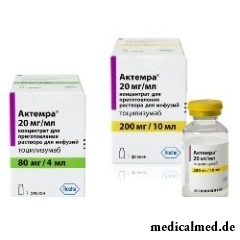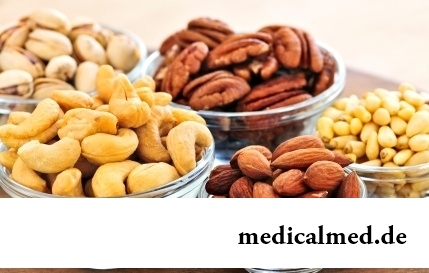





Aktemra
Application instruction:
 Aktemra – drug with an immunodepressive effect.
Aktemra – drug with an immunodepressive effect.
Form of release and structure
Dosage forms of release of Aktemra:
- Solution for hypodermic introduction: transparent or opalescent, colourless or slightly yellowish liquid (on 0,9 ml in unit-dose syringes, on 4 unit-dose syringes in a cardboard pack or on 1 unit-dose syringe in an autoinjector, on 4 autoinjectors in a cardboard pack);
- Concentrate for preparation of solution for infusions: transparent or opalescent, colourless or light yellow (in bottles on 4, 10 or 20 ml, on 1 or 4 bottles in a cardboard pack).
Structure of 0,9 ml (1 unit-dose syringe) of solution for hypodermic introduction:
- Active agent: тоцилизумаб – 162 mg;
- Auxiliary components: A L-histidine – 1,4 mg; L-methionine – 4,03 mg; L-arginine – 0,132 mg; polysorbate of 80 - 0,18 mg; monohydrate of a hydrochloride of a L-histidine – 1,9 mg; a hydrochloride of L-arginine – 18,8 mg; water for injections – to 0,9 ml.
Structure of 1 ml of a concentrate for preparation of infusion solution:
- Active agent: тоцилизумаб – 20 mg;
- Auxiliary components: polysorbate of 80 - 0,5 mg; sucrose – 50 mg; hydrosodium phosphate dodecahydrate – in enough; a dihydrosodium phosphate dihydrate – in enough, water for injections – in enough.
Indications to use
- Pseudorheumatism with a high or average degree of activity at adults – as monotherapy or in combination with a methotrexate and/or with other basic antiinflammatory medicines, including for the purpose of braking of the destruction of joints proved radiological;
- Active polyarticulary system idiopathic juvenile arthritis at adults and children of 2 years – as monotherapy or in combination with a methotrexate (infusion solution).
Contraindications
Absolute:
- Active infectious diseases, including tuberculosis;
- The combined use with tumor necrosis factor inhibitors an alpha (ФНОα) or use within one month after the end of therapy of ANTI-FNO antibodies;
- Age up to 2 years (at treatment of polyarticulary system idiopathic juvenile arthritis) and up to 18 years (at treatment of a pseudorheumatism);
- Hypersensitivity to drug components.
With care Aktemra is appointed at such states / diseases, with observance of recommendations:
- Infections: existence of instructions in the anamnesis on recurrent infectious diseases, and also at associated diseases which contribute to developing of infections (because of risk of development of infectious diseases). When developing serious infections treatment is interrupted before elimination of an infection;
- Diverticulitis complications: existence of instructions in the anamnesis on cankers of bodies of digestive tract or a diverticulitis (because of probability of development of perforation of a diverticulum). At emergence of the symptoms which are perhaps indicating the complicated diverticulitis it is necessary to conduct immediately examination for early identification of perforation of digestive tract;
- Liver failure and active diseases of a liver: therapy by Aktemra, in particular at the combined use with a methotrexate, can be associated with increase in activity of hepatic transaminases;
- Demyelinating diseases of the central nervous system: control of a state is necessary for early identification of symptoms which can indicate a course of a disease;
- Increase in activity of hepatic transaminases (without symptoms of a liver failure): frequency of disturbances increases at the combined use with medicines with a potential hepatotoxic action (for example, a methotrexate). Care it is necessary to respect at exceeding of the upper bound the rules of indicators аланинаминотрансферазы/аспартатаминотрансферазы, it is more than by 1,5 times (at exceeding more, than by 5 times, treatment is cancelled);
- Changes of indicators of lipidic exchange: because of risk of increase in indicators of lipidic exchange, at a pseudorheumatism it is necessary to estimate its level 1 time at the period from 4 to 8 week from the beginning of a medical course.
At pregnancy use of drug is possible only at obvious clinical need. The feeding women for Aktemra's appointment need to correlate the expected advantage to possible harm for the child (the profile of safety is not studied).
Route of administration and dosage
Solution for hypodermic introduction
Aktemra should be entered with use of an autoinjector or one-time the syringe tube. Intravenously it is impossible to administer the drug.
The first injection needs to be carried out under observation of the health worker having necessary qualification. It is recommended to change injection sites of solution (a front abdominal wall, a shoulder or a hip). Does not follow to administer the drug in the field of hematomas, scars, reddenings, birthmarks, in skin with hypersensitivity, consolidations and damages.
Before use it is necessary to be convinced of lack of opacification of solution, change of coloring and presence of strangers inclusion.
At treatment of a pseudorheumatism Aktemra is entered in a dose of 162 mg once a week. Performing monotherapy or the combined use with a methotrexate and/or other basic medicines with antiinflammatory action is possible.
In case of transition of the patient from Aktemra's introduction, intravenous on a hypodermic way, the first injection it is necessary to make instead of planned intravenous infusion (clinical performance of active agent at hypodermic introduction is comparable to that at intravenous administration).
At emergence of symptoms of serious allergic reactions rendering immediate medical care can be required.
Correction of the mode of dosing at increase in activity of liver enzymes, depending on exceeding of the upper bound of norm – VGN:
- VGN> 1-3 times: before normalization of indicators of alaninaminotranspherase or aspartate aminotransferase frequency rate of introduction is reduced to 1 injection in 2 weeks. Carrying out dose adjustment of at the same time used antiinflammatory drugs is possible;
- VGN> 3-5 times: therapy is interrupted before reduction of an indicator up to level less than by 3 times exceeding the upper bound of norm. Then therapy can be resumed according to instructions;
- VGN> 5 times: therapy is cancelled.
Correction of the mode of dosing at low absolute number of neutrophils – AChN (at value of an indicator – number клеток×109/л):
- AChN> 1: correction is not required;
- AChN 0,5-1: therapy is interrupted. Its resuming is possible at increase in an indicator to> 100×109/мкл at frequency rate of introduction of 1 times each 2 weeks. At clinical need are returned to the standard mode of dosing;
- AChN <0,5: therapy is cancelled.
Correction of the mode of dosing at low number of thrombocytes (at value of an indicator – number клеток×103/мкл):
- 50-100: therapy is interrupted. Its resuming is possible at increase in an indicator to> 100×103/мкл at frequency rate of introduction of 1 times each 2 weeks. At clinical need are returned to the standard mode of dosing;
- <50: therapy is cancelled.
Infusion solution
Aktemra is entered intravenously kapelno.
The recommended single dose at treatment of a pseudorheumatism – 8 mg/kg (enter, at least, for 1 hour). Frequency rate of use – 1 time in 4 weeks.
The maximum single dose for patients weighing more than 100 kg – 800 mg.
Before introduction the nurse or the doctor in aseptic conditions have to part a concentrate of 0,9% with sodium chloride solution. The prepared infusion solution physically is also chemically stable for 24 hours at a temperature of 30 °C (if it is not used at once, its storage is possible at a temperature of 2-8 °C during the specified period).
Before use it is necessary to be convinced of lack of opacification of solution, change of coloring and presence of strangers inclusion.
Correction of the mode of dosing at increase in activity of liver enzymes (depending on exceeding of the upper bound of norm):
- VGN> 1-3 times: to lower a dose to 4 mg/ml or to interrupt therapy before normalization of indicators of alaninaminotranspherase or aspartate aminotransferase. Further treatment is resumed in a dose of 4 or 8 mg/kg. Carrying out dose adjustment of at the same time used antiinflammatory drugs is possible;
- VGN> 3-5 times: therapy is interrupted before reduction of an indicator up to level less than by 3 times exceeding the upper bound of norm. Then therapy can be resumed according to instructions; at the steady increase in indicators confirmed at a repeated research, therapy is cancelled;
- VGN> 5 times: therapy is cancelled.
Correction of the mode of dosing at low absolute number of neutrophils (at value of an indicator – number клеток×109/л):
- AChN> 1: correction is not required;
- AChN 0,5-1: therapy is interrupted. Its resuming is possible at increase in an indicator to> 100×109/мкл in a dose of 4 mg/kg. At clinical need are returned to the standard mode of dosing;
- AChN <0,5: therapy is cancelled.
Correction of the mode of dosing at low number of thrombocytes (at value of an indicator – number клеток×103/мкл):
- 50-100: therapy is interrupted. Its resuming is possible at increase in an indicator to> 100×103/мкл in a dose of 4 mg/kg. At clinical need are returned to the standard mode of dosing;
- <50: therapy is cancelled.
The recommended dosing mode at treatment of polyarticulary juvenile idiopathic arthritis (a single dose with frequency rate of introduction of 1 times in 4 weeks, depending on body weight):
- <30 kg: 10 mg/kg;
- ≥30 kg: 8 mg/kg.
Dose adjustment is possible only at permanent change of weight.
The recommended dosing mode at treatment of system juvenile idiopathic arthritis (a single dose with frequency rate of introduction of 1 times in 2 weeks, depending on body weight):
- <30 kg: 12 mg/kg;
- ≥30 kg: 8 mg/kg.
Dose adjustment is possible only at permanent change of weight.
Side effects
Probable side reactions (it is very frequent (≥1/10), it is frequent (≥1/100 and <1/10), infrequently (≥1/1000 and <1/100), it is rare (≥1/10 000 and <1/1000), it is very rare (<1/10 000 taking into account separate cases):
- Cardiovascular system: often – increase in arterial pressure;
- Nervous system: often – a headache, dizziness;
- Alimentary system: often – ulcers of an oral cavity, an abdominal pain, gastritis; infrequently – stomatitis, perforation of digestive tract, stomach ulcer;
- Endocrine system: infrequently – a hypothyroidism;
- Immune system: often – hypersensitivity reactions; infrequently – anaphylactic reactions.
- Respiratory system: often – cough, short wind;
- Urinary system: infrequently – a nephrolithiasis;
- System of a hemopoiesis: often – a leukopenia, a neutropenia;
- Body weight and laboratory indicators: often – increase in activity of hepatic transaminases, increase in weight; infrequently – increase in the general bilirubin;
- Skin and its appendages: often – rash, urticaria, an itch, phlegmon;
- Infections: very often – upper respiratory tract infections; often – the infections caused by Herpes simplex of 1 type and Herpes zoster; infrequently – a diverticulitis;
- Organ of sight: often – conjunctivitis;
- Metabolism: often – a hypercholesterolemia; infrequently – a gipertriglitseridemiya;
- Organism in general: often – peripheral hypostases.
Additional information on side reactions at treatment of a pseudorheumatism at use of drug in any dosage form:
- Reactions in the place of hypodermic introduction: erythema, itch, pain, hematoma. As a rule, they proceed in easy or moderate severity, pass independently and do not lead to cancellation of therapy;
- Reactions after infusion: episodes of increase in arterial pressure. For 24 hours after the end of introduction of Aktemra there can be a headache and reactions from integuments (in the form of rash, a small tortoiseshell). These disturbances usually do not lead to therapy restriction;
- Immunogenicity: at 0,8% of the inspected patients antibodies to a totsilizumab were revealed. Neutralized antibodies were revealed at all patients;
- Perforation of digestive tract: in most cases in the form of the complications of a diverticulitis including abscess, fistula, perforation of lower parts of digestive tract, diffuse purulent peritonitis;
- Infections (development of the following diseases is possible): the phlegmon, pneumonia, infections caused by Herpes zoster, bacterial arthritis, a diverticulitis, a gastroenteritis, sepsis, in certain cases they were followed by a fatal outcome. Development of opportunistic infections is recorded.
Additional information on side reactions at treatment of polyarticulary juvenile idiopathic arthritis at Aktemra's use in the form of infusion solution:
- Infections: most often upper respiratory tract infections and a nasopharyngitis develop. Much more often these disturbances were observed at patients with body weight <30 kg;
- Reactions after infusion: in character do not differ from those which developed at patients with a pseudorheumatism;
- Immunogenicity: an isolated case of existence of antibodies to a totsilizumab without hypersensitivity reaction development.
Additional information on side reactions at treatment of polyarticulary system idiopathic arthritis at Aktemra's use in the form of infusion solution (in most cases they do not differ from those at patients with a pseudorheumatism):
- Reactions after infusion: undesirable effects in the place of intravenous administration: a small tortoiseshell (the serious phenomenon), rash, an arthralgia, discomfort in epigastriums, diarrhea, a headache, etc. Clinically significant reactions of hypersensitivity demanding drug withdrawal are seldom or never registered;
- Infections: are similar to the diseases which are observed at a pseudorheumatism except average otitis and chicken pox;
- Immunogenicity: antibodies to active agent are revealed at 2 of 112 inspected patients. In 1 case the hypersensitivity reaction which demanded treatment cancellation developed.
Special instructions
Any another biological drugs need to coordinate Aktemra's replacement with the attending physician.
During therapy it is necessary to consider:
- Hypersensitivity reactions: as a result of post-marketing use of drug for intravenous administration the serious reactions of hypersensitivity including an anaphylaxis were recorded. The patients who earlier had reactions of hypersensitivity at the combined use with premedication glucocorticosteroids and antihistaminic medicines can have heavy these disturbances and potentially fatal. In case of development of anaphylactic reactions or other serious reactions of hypersensitivity Aktemr should cancel immediately and to carry out the corresponding treatment. Further it is impossible to use drug;
- Tuberculosis: before purpose of therapy it is necessary to conduct preliminary survey of the patient on existence of latent tuberculosis. In case of its identification, before Aktemra's appointment, conduct a standard course of antimikobakterialny therapy;
- Immunization: it is not necessary to carry out immunization by live and live attenuated vaccines during performing therapy (the profile of safety is not established). Before Aktemra's appointment performing vaccination according to a national calendar of inoculations is recommended (with observance of an interval);
- Reactivation of viral infections: cases of reactivation of a viral infection are recorded (for example, a viral hepatitis In). Patients with a positive take at a screening on hepatitis did not join in clinical trials of drug;
- Changes of laboratory indicators: development of a neutropenia and thrombocytopenia is possible.
At patients with system juvenile idiopathic arthritis the syndrome of activation of macrophages (a serious zhizneugrozhayushchy state) can develop. The profile of safety of Aktemra in this case was not studied.
During Aktemra's use development of dizziness in this connection at its emergence it is recommended to patients to refuse control of motor transport before normalization of a state can be observed.
Medicinal interaction
Clinically significant influence on exposure of a methotrexate the combined use of 10 mg/kg of Aktemra from 10-25 mg of a methotrexate at frequency rate of introduction is not revealed once a week.
Simultaneous use with other medicines with antiinflammatory action was not studied.
Terms and storage conditions
To store in protected from light, the place, unavailable to children, at a temperature of 2-8 °C, not to freeze.
Period of validity – 2,5 years.
Name of drug
Price
Drugstore
In operating time our brain spends the amount of energy equal to the 10 Watts bulb. So the image of a bulb over the head at the time of emergence of an interesting thought is not so far from the truth.

Herpes simplex of the first type (the infectious disease which is shown periodic bubble rashes on is called...
Section: Articles about health
For the city dweller the fitness is the most convenient sport. It is enough to acquire the subscription to the gym to get access to various apparatuses and an opportunity to train under the leadership of the experienced consultant. Many consider fitness on...
Section: Articles about health
Each person has easy indispositions which he transfers "standing", trying not to ask for medical care. Arguments at the same time are adduced same: "it is a trifle, itself will pass", "I have too many important issues", "there are no wish to spend time for doctors", etc. At good shape of health, normal working capacity and lack of suspiciousness dislike for complaints to such problems is quite natural. It is not the most correct, but very widespread type of behavior. I am glad...
Section: Articles about health
All like to sing. Small children with pleasure are engaged in a vocal, not especially thinking of hit in a melody. Adults most often...
Section: Articles about health
The state of health of the person depends on many factors. One of the most important is the constant, but not exhausting a physical activity. In the presence of various illnesses specialists often advise patients to do swimming which by right borrows ведущ...
Section: Articles about health
Each of us faces from time to time that other people need the immediate help. We react to it differently: one at once call doctors and police, others rush to victims and try to save them independently. Some pass by at all … Certainly, desire to help the neighbor who got into trouble, quite naturally for any decent person. However not everyone understands that to work in a similar situation, being guided by exclusively good...
Section: Articles about health
The metabolism at each person proceeds in own way. However dependence between the speed of this process and disposal from superfluous in...
Section: Articles about health
The person, as well as all other beings living on our planet feels weather changing. It is the normal meteosensitivity which is not causing to healthy people of special troubles. Meteodependence, on the contrary, is morbid condition, характеризующимс...
Section: Articles about health
White teeth and the Hollywood smile – a dream of many people. Long time was considered that the plaque on teeth and change of their color – destiny of those who incorrectly eat smokes and badly brushes teeth. But the paradox is available: at everything the variety of toothpastes, brushes existing today for toothbrushing and conditioners for a mouth the number of the people hesitating of a plaque on teeth does not decrease. Moreover, the plaque is formed even at small children who definitely do not smoke and have no coffee. So in what business, and опас...
Section: Articles about health
You are office worker, the driver, the fan of winter sports or do not think of life without bicycle? You conduct a slow-moving image жизн...
Section: Articles about health
Modern footwear is extremely various. It stopped being only protection for legs long ago. Today shoes, boots, barefoot persons choose not so much proceeding from their convenience and functionality how many being guided by outward, brand and an opportunity to add with it...
Section: Articles about health
Any of us is not insured from a heavy illness of the loved one. Happens and so that someone from family members becomes the bed patient, and remains in such state for a long time. It extremely suppresses both the most injured, and all its house which life considerably changes....
Section: Articles about health
The main role in development of a peptic ulcer of a stomach and duodenum the bacterium Helikobakter plays pilor. Activity and Wuxi...
Section: Articles about health
The problem of diagnosis was and remains to one of the most important in medicine. From that, the reason of an indisposition of the patient will be how precisely defined, eventually success of treatment depends. In spite of the fact that the majority of the diagnostic methods applied in about...
Section: Articles about health
Sometimes it seems that modern society was divided into two camps: representatives of the first are sure that only the woman has to be responsible for contraception, representatives of the second, respectively, are sure that it is destiny of men. Meanwhile the question of contraception has very many aspects – both psychological, and legal and, of course, medical....
Section: Articles about health
The technique of acupuncture (acupuncture) is used in the medical purposes more than three and a half millennia. It widely races...
Section: Articles about health
The body of the person almost for 60% consists of water. It is so important for normal functioning of an organism that loss of only one and a half percent of liquid already leads to the most unpleasant effects. The problems connected with deficit of water can overtake and...
Section: Articles about health
Coffee – favourite drink of many. For the last decades it more than once already declared very harmful, extremely useful and even necessary for normal life activity. In spite of the fact that this product became for us usual for a long time, there are many myths about properties of coffee and its impact on a human body. Readers can get acquainted with the most widespread of similar delusions today....
Section: Articles about health
The brain of the person is studied not one hundred years, but the quantity of the riddles connected with this body increases rather, than reducing...
Section: Articles about health
Visit of doctors – business not the most pleasant, and many people do not hurry to undergo necessary planned inspections. Such behavior is extremely thoughtless and improvident. Our health is necessary not only to us: wellbeing of darlings, children, grandsons and престар...
Section: Articles about health
The unpleasant feelings connected with spring breakdown are familiar almost to each of us. Often happens that in March-April on the person weakness leans: he suffers from drowsiness, complains of bad mood, loss of interest in life and failures in affairs....
Section: Articles about health
Bulimia and anorexia, are heavy deviations of a feeding behavior, become a cause of death of patients much more often than all others...
Section: Articles about health
Several decades ago the basil (the district khan, реан, Reagan) was considered as a part of the Caucasian or east cuisine, but today it strongly took the place on tables of Russians. Greens of this plant possess a strong, pleasant smell and specific fresh taste, because of to...
Section: Articles about health
Stroke (acute disorder of cerebral circulation) – one of the most widespread neurologic diseases. Annually in the world more than 6 million people die of this illness. From the survived patients about 80% become disabled people, and nearly a third from them needs afterwards permanent care. In fact, the stroke creates a situation at which a part of cells of a brain loses blood access, loses an opportunity to receive oxygen and nutrients, and perishes. As a result of a razviv...
Section: Articles about health
The modern person not always manages to find housing in the environmentally friendly region and such work which would not do harm здо...
Section: Articles about health
The medicine promptly develops, and the fact that else quite recently it seemed by miracle can now. We are not surprised any more to the fact that people with artificial joints and extremities can play sports, organ transplantation became a routine, and the latest cancer medicine п...
Section: Articles about health
When overcomes feeling of hunger, and an opportunity to have dinner fully is absent, having a snack − the meals, small on volume, stabilizing sugar level in blood comes to the rescue. The relation of nutritionists to having a snack more often negative, but only because as snack people choose the most caloric products with the increased amount of "bystry" carbohydrates: cookies, rolls, chips, candies. Nevertheless, the advantage of having a snack is obvious to weight loss: the person avoids strong feeling of hunger...
Section: Articles about health

